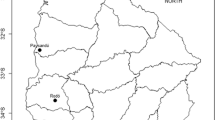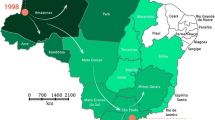Abstract
Ascochyta blight is the most destructive foliar pathogen of field peas. The amount of yield loss resulting from the disease in Australia is mainly driven by primary infection from wind-borne ascospores of Didymella pinodes. In this study, a model was developed to predict the spread of ascospores from the ascochyta blight infected field pea stubble of previous season’s crops. The model was adapted from a previously developed spatiotemporal model and calibrated with field experimental data consisting of release events of ascospores of D. pinodes from known source for 21 consecutive weeks, under natural environmental conditions, in a 400 m by 400 m area. The model was then applied in a 30.9 km by 36.8 km area in a major field pea growing region of Western Australia to show the magnitude and spatial diversity of the dispersal of ascospores, generated in previous season’s field pea stubble, could differ between growing seasons. This simulation was only tested subjectively. It is concluded that a properly validated simulation of this type has potential for understanding the value of physical separation of the current season field pea crop from previous season’s stubble, visualising the scale and diversity of ascospore dispersal as an educational tool for growers and consultants, and deriving the “magic figure” of the intensity of field pea area that could result in the presence of ascospores everywhere in a region.




Similar content being viewed by others
References
Aubertot JN, West JS, Bousset-Vaslin L, Salam MU, Barbetti MJ, Diggle AJ (2006) Improved resistance management for durable disease control: A case study of phoma stem canker of oilseed rape (Brassica napus). Eur J Plant Pathol 114:91–106
Bretag TW (1991) Epidemiology and control of ascochyta blight of field peas. PhD Thesis. La Trobe University, Australia
Bretag TW, Keane PJ, Price TV (1995) Effect of ascochyta blight on grain yield of field peas (Pisum sativum L.) grown in southern Australia. Aust J Exp Agric 35:531–536
Bretag TW, Keane PJ, Price TV (2006) The epidemiology and control of ascochyta blight in field peas: a review. Aust J Agric Res 57:883–902
Davidson JA, Hartley D, Priest M, Herdina MK-K, McKay A, Scott ES (2009) A new species of Phoma causes achochyta blight symptoms of field peas (Pisum sativum) in South Australia. Mycologica 101:120–128
Diggle AJ, Salam MU, Thomas GJ, Yang HA, O’Connell M, Sweetingham MW (2002) AnthracnoseTracer: A spatiotemporal model for simulating the spread of anthracnose in an lupin field. Phytopathology 92:1110–1121
French B, Pritchard I, Seymour M, Riethmuller G (2005) Crop management: Growing field pea. In: Producing Pulses in the Southern Agricultural Region, pp. 19–32. Department of Agriculture, Western Australia
Galloway J, MacLeod WJ (2003) Didymella rabiei, the teleomorph of Ascochyta rabiei, found on chickpea stubble in Western Australia. Australas Plant Pathol 32:127–128
Madden LV, Hughes G (1995) Plant disease incidence: Distributions, heterogeneity, and temporal analysis. Annu Rev Phytopathol 33:529–564
McMurray LS, Davidson JA, Lines MD, Leonforte AL, Salam MU (2011) Combining pathological, agronomic and breeding advances to maximise Pisum sativum yields under changing climatic conditions in south-eastern Australia. Euphytica. doi:10.1007/s10681-011-0362-9
Peever TL, Barve MT, Stone LJ, Kaiser WJ (2007) Evolutionary relationships among Ascochyta species infecting wild and cultivated hosts in legume tribes Cicereae and Vicieae. Mycologia 99:59–77
Salam MU, Khangura RK, Diggle AJ, Barbetti MJ (2003) Blackleg Sporacle: A model for predicting onset of pseudothecia maturity and seasonal ascospore showers in relation to blackleg of canola. Phytopathology 93:1073–1081
Salam MU, Galloway J, MacLeod WJ, Davidson JA, Seymour PI, Salam KP, Diggle AJ, Maling M (2011) G1 Blackspot Manager model predicts the maturity and release of ascospores in relation to ascochyta blight of field pea. Australas Plant Pathol. doi:10.1007/s13313-011-0035-0
Schoeny A, Jumel S, Rouault F, Le May C, Tivoli B (2007) Assessment of airborne primary inoculum availability and modelling of disease onset of ascochyta blight in field peas. Eur J Plant Pathol 119:87–97
Xu XM, Ridout MS (1998) Effects of initial epidemic conditions, sporulation rate, and ascospore dispersal gradient on the spatio-temporal dynamics of plant disease epidemics. Phytopathology 88:1000–1012
Zadoks JC, van den Bosch F (1994) On the spread of plant disease: A theory on foci. Annu Rev Phytopathol 32:503–521
Acknowledgements
We thank the Grains Research and Development Corporation (GRDC) of Australia for financial assistance in this work.
Author information
Authors and Affiliations
Corresponding author
Rights and permissions
About this article
Cite this article
Salam, M.U., Galloway, J., Diggle, A.J. et al. Predicting regional-scale spread of ascospores of Didymella pinodes causing ascochyta blight disease on field pea. Australasian Plant Pathol. 40, 640–647 (2011). https://doi.org/10.1007/s13313-011-0064-8
Received:
Accepted:
Published:
Issue Date:
DOI: https://doi.org/10.1007/s13313-011-0064-8




